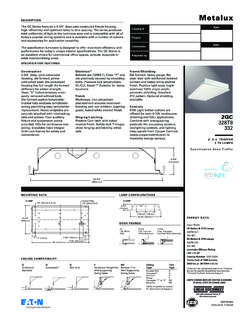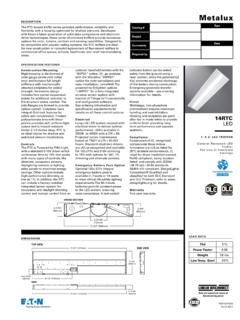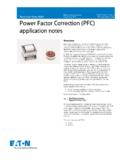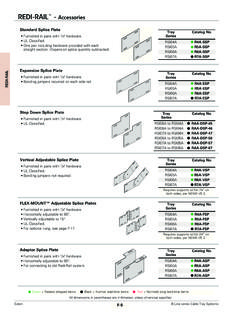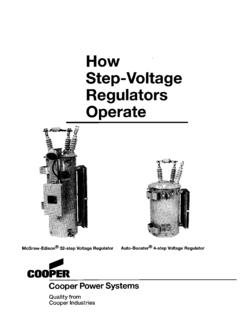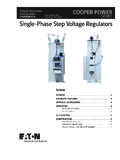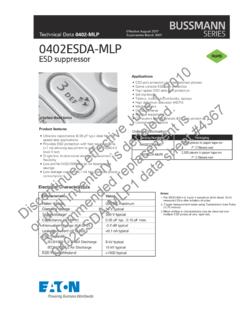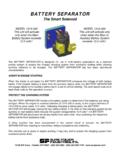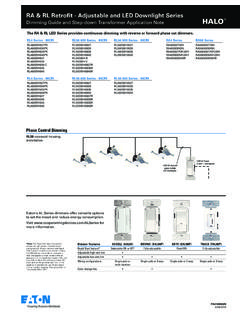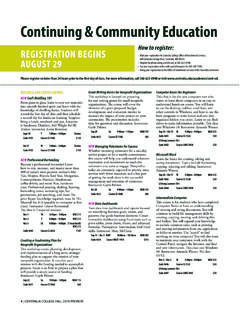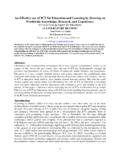Transcription of Fuseology - Cooper Industries
1 14 classes of FusesSafety is the industry mandate. However, proper selection, overall functionalperformance and reliability of a product are factors which are not within thebasic scope of listing agency activities. In order to develop their safety testprocedures, listing agencies develop basic performance and physical specifications or standards for a product. In the case of fuses, these standardshave culminated in the establishment of distinct classes of low-voltage (600volts or less) fuses, classes RK1, RK5, G, L, T, J, H and CC being the fact that a particular type of fuse has, for instance, a classification of RK1,does not signify that it has the identical function or performance characteristicsas other RK1 fuses.
2 In fact, the Limitron non-time-delay fuse and the Low-Peak dual-element, time-delay fuse are both classified as RK1. Substantial difference in these two RK1 fuses usually require considerable difference insizing. Dimensional specifications of each class of fuse does serve as a uniform R FusesClass R ( R for rejection) fuses are high performance, 1 10to 600A units, 250 Vand 600V, having a high degree of current-limitation and a short-circuit interrupting rating of up to 300,000A (RMS symmetrical). Cooper BussmannClass R s include classes RK1 Low-Peak and Limitron fuses, and RK5 Fusetron fuses.
3 They have replaced Cooper Bussmann K1 Low-Peak andLimitron fuses and K5 Fusetron fuses. These fuses are identical, with theexception of a modification in the mounting configuration called a rejectionfeature . This feature permits Class R to be mounted in rejection type fuse-clips. R type fuseclips prevent older type Class H, ONE-TIME and RENEWABLE fuses from being installed. Since Class H fuses are not current-limiting and are recognized by regulatory agencies as having only a 10,000 Ainterrupting rating, serious damage could result if a Class R fuse werereplaced by a Class H fuse.
4 The use of Class R fuse holders is thus an important safeguard. The application of Class R fuses in such equipment asdisconnect switches permits the equipment to have a high short-circuit currentrating. NEC requires that protective devices have adequate capacity tointerrupt short-circuit currents. NEC (B) requires fuse holders for current-limiting fuses to reject non-current-limiting type illustration above shows Class R type fuse rejection clips, which accept only theClass R rejection type Listed FusesBranch-circuit listed fuses are designed to prevent the installation of fuses thatcannot provide a comparable level of protection for characteristics of branch-circuit fuses are:1.
5 They must have a minimum interrupting rating of 10, They must have a minimum voltage rating of They must be size rejecting such that a fuse of a lower voltage rating cannot beinstalled in the They must be size rejecting such that a fuse with a current rating higher than thefuse holder rating cannot be installed. 2005 Cooper BussmannFuseologyCooper Bussmann Branch Circuit, Low Voltage Power Distribution FusesIn the above illustration, the fuse on the right has a grooved ring in one ferrule, providing the rejection feature of the Class R fuse in contrast to the lower interruptingrating, non-rejection Bussmann high performance fuses are used in tens of thousands of industrial plants, commercial buildings, and homes throughout the world.
6 2005 Cooper Bussmann15 FuseologyCooper Bussmann Branch Circuit, Power Distribution FusesCUBEFuse (Dual-Element,Time-Delay)TCF (600 Vac), 1 to 100A,Current-Limiting, UL ListedSpecial Purpose Fuse, STD248-8 Class J PerformanceUL Guide # JFHR, UL File #E56412, 300,000 AIR ac,(300 Vdc 100,000 AIR), CSAC lass #1422-02, CSA File#53787, 200,000 AIR ac,(300 VDC 100,000 AIR)TCF fuses meet UL Class JTime-Delay electrical performancerequirements. It is the world s firstfinger-safe fuse with the smallest installedfootprint of any power class fuse including Class J, CC, Tand R fuses.
7 Satisfies requirements of IEC 60529 for IP-20 finger safe rating and provides TYPE 2 no damage protection for motor starters when sized properly. TheTCF provides open fuse indication and is 35mm DIN railand panel Sheet No. 9000 Low-Peak (Dual-Element, Time-Delay)LPS-RK_SP (600 Vac), LPN-RK_SP (250 Vac), 1 10to 600A,Current-Limiting, STD 248-12 Class RK1 LPN-RK_SP 0-60A (125 Vdc, 50,000 AIR), 65-600A (250 Vdc,50,000 AIR), LPS-RK_SP 0-600A (300 Vdc, 50,000 AIR)UL Guide #JFHR, UL File #E56412, 300,000 AIR ac, CSAC lass #1422-02, CSA File #53787, 200,000 AIR acHigh performance, all-purpose fuses.
8 Provide the very highdegree of short circuit limitation of Limitron fuses plus theoverload protection of Fusetron fuses in all types of circuitsand loads. Can be closely sized to full-load motor currentsfor reliable motor overload protection, as well as backupprotection. Close sizing permits the use of smaller andmore economical switches (and fuses); better selectivecoordination against blackouts; and a greater degree ofcurrent-limitation (component protection), Low-Peak fusesare rejection type but also fit non-rejection type fuse holders. Thus, can be used to replace Class H, K1, K5,RK5 or other RK1 Sheet No.
9 1001, 1002, 1003, 1004 For Data Sheets: (Time-Delay)KRP-C_SP (600 Vac), 601 to 6000A, Current-Limiting STD 248-10 Class LUL Guide #JFHR, UL File #E56412, 300,000 AIR ac, 601-2000A (300 Vdc 100,000 AIR), CSA Class #1422-02, CSAFile #53787, 200,000 AIR ac The all-purpose fuse for both overload and short circuitprotection of high capacity systems (mains and large feeders). Time-delay (minimum of four seconds at fivetimes amp rating) for close sizing. Unlike fast-acting fuses,time-delay fuses pass harmless surge currents of motors,transformers, etc., without overfusing or any sacrifice ofshort-circuit current limitation (component protection).
10 The combination use of 1 10to 600A Low-Peak dual-element time-delay fuses and 601 to 6000A KRP-C Low-Peakfuses is recommended as a total system selectivelycoordinated for blackout protection. Sizeof upstream fuse need only be twice that of downstreamLow-Peak fuses (2:1 ratio). Low-Peak fuses can reducebus bracing; protect circuit breakers with low interruptingrating as well as provide excellent overall protection of circuits and Sheet No. 1008, 1009 Low-Peak (Dual-Element, Time-Delay)LPJ_SP (600 Vac), 1 to 600A, Current-Limiting, STD 248-8 Class JUL Guide #JFHR, UL File #E56412, 300,000 AIR ac, 1 to600A (300 Vdc 100,000 AIR), CSAC lass #1422-02, CSAFile #53787, 200,000 AIR ac Space saving LPJ fuses have the advantage of time- delay, permitting them to pass temporary overloads, offering overload,back-up overload, and short circuit protection.
